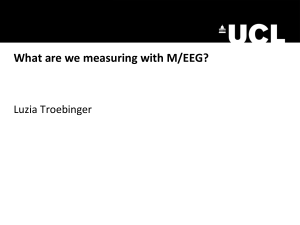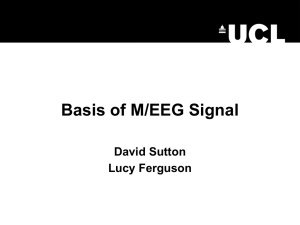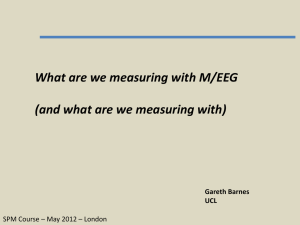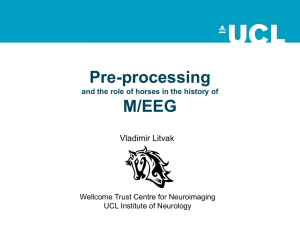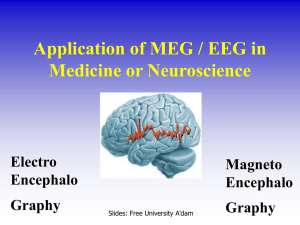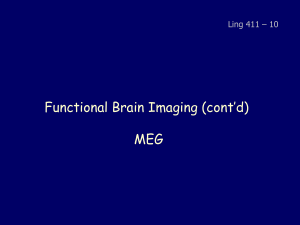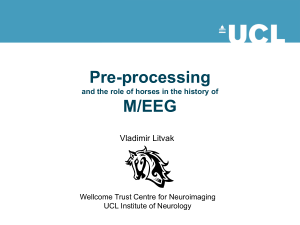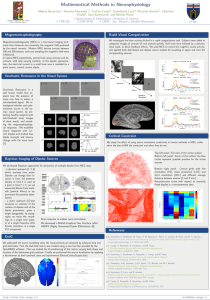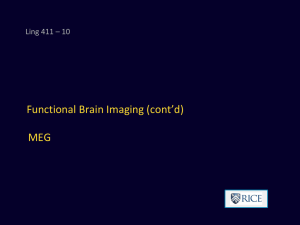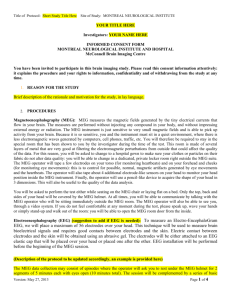Magnetoencephalography
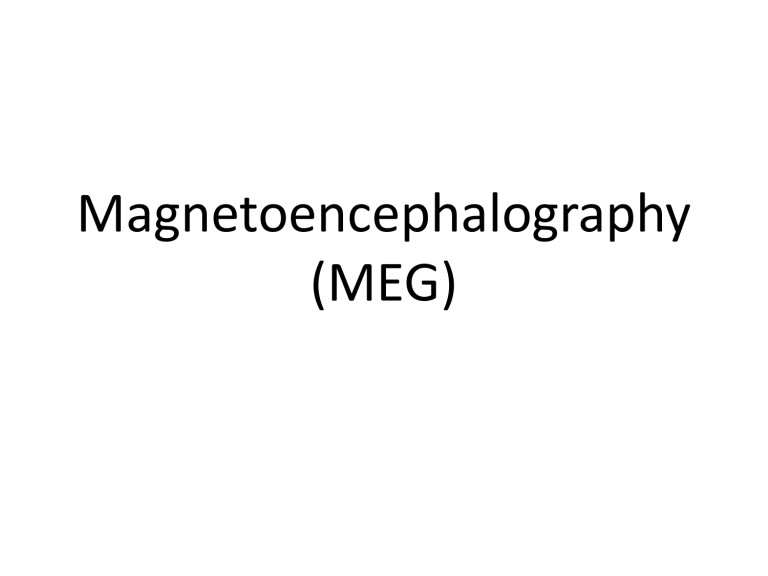
Magnetoencephalography
(MEG)
• Description
• Applications
• Issues
Overview
Magnetography
• Term used to describe a recording of the magnetic field that accompanies a bioelectric event
• Movement of electric charge gives rise to a magnetic field
• Depolarization & repolarization translocation of ions movement of charge
give rise to magnetic field detected with suitable eqipment
• Magnetogram & electrogram: common origin
reflect the same event but provides a different type of information
• Magnetic fields pass freely through living tissue little attenuation of magnetic field
• No need for contact with the body to record magnetogram electrodeless recording
• Magnetic field by active tissues measured by voltage induced in search coil
• Detector represent first derivative of bioelectric event
• Field low intensity necessary to use magnetic shielding and/or signal averaging to obtain adequate SNR
SQUID : Superconducting Quantum
Interference Device
MEG
• MEG : non-invasive tool to study epilepsy and brain function.
• MEG measures small electrical currents arising inside the neurons of the brain.
• These currents produce small magnetic fields.
• MEG generates a accurate representation of the magnetic fields produced by the neurons.
• To some degree, MEG is similar to EEG.
• An important difference is that the skull and the tissue surrounding the brain affect the magnetic fields measured by MEG much less than they affect the electrical impulses measured by EEG.
• The advantage of MEG over EEG is therefore greater accuracy owing to the minimal distortion of the signal.
• This allows for more usable and reliable localization of brain function.
• The combination of the images of and MRI extremely helpful
– for identifying areas of the brain that may be generating a potential for seizures
– for localizing the electrical activity in normal brain function.
MEG
• Passive measurement of minute current dipoles and corresponding magnetic moments
• Magnetic field generated by neurons on the order of tens of femtoTeslas
• High resolution in both space (2 - 3mm) and time (<1ms)
Why is an MEG performed?
• In the evaluation of epilepsy, MEG is used to localize the source of epileptiform brain activity.
• Usually performed with simultaneous EEG.
• MEG may be helpful in the following situations:
– Seizure localization
– Lesion
– Tumours
• It can improve the detection of potential sources of seizures by revealing the exact location of the abnormalities, which may then allow physicians to find the cause of the seizures.
• It can help when MRI scans show a lesion but the EEG findings are not entirely consistent with the MRI information.
• In patients who have brain tumors or other lesions, the MEG may be able to map the exact location of the normally functioning areas near the lesion prior to surgery.
• In patients who have had past brain surgery, the electrical field measured by EEG may be distorted by the changes in the scalp and brain anatomy. If further surgery is needed, MEG may be able to provide necessary information without invasive EEG studies.
Magnetoencephalography - Apparatus
• Patient wears a helmet containing an array of
100+ sensitive magnetic field measurement devices
• Measurement devices are called SQUIDs –
Superconducting Quantum Interference
Devices
• Measurements must occur in costly magnetically shielded room
Magnetoencephalography - Apparatus
• Lead shell must be kept below 8 Kelvin for superconducting properties
• Surface Meissner currents expel external magnetic fields, reducing noise by six orders of magnitude
Magnetoencephalography - Apparatus
• Screen is used for patient stimulation for functional mapping
Magnetoencephalography -
Applications
• Epilepsy diagnosis
• Functional Imaging and Mapping
Magnetoencephalography – Epilepsy
Diagnosis
• Epilepsy is a condition wherein a patient suffers from repeated seizures that originate in the brain.
• Manifested by extraordinarily high localized brain activity.
• MEG ideal to locate such epileptic centers for surgical removal
Magnetoencephalography – Epilepsy
Diagnosis
Epileptic seizure scan data and postprocessing
Magnetoencephalography – Epilepsy
Diagnosis
• Previous method: Intracranial
Electroencephalography
• Invasive surgery to lay EEG sensor network directly on the brain
• Network connected to EEG monitor in hospital intensive care units.
Magnetoencephalography –
Functional Imaging
• Functional Imaging utilizes the high temporal resolution to generate real time brain scans
• Doctors can use these scans to determine how the brain reacts to various stimuli
• Multiple scans allow a brain map to be built, providing a base to begin research linking neural activity to specific classes of stimuli
Magnetoencephalography –
Functional Imaging
• An averaged somatosensory evoked response from a tactile stimulation of the second right digit.
• Dipole fit results for this scan.
Issues
• Noise – the background magnetic field of the earth is roughly 60 microTesla, approximately
9 orders of magnitude greater than that generated by the neurons of the brain
• Reconstruction of imagery is inherently ill posed, as it is an inverse problem of Maxwell’s
Equations
• Mathematics of the reconstruction well beyond the scope of this presentation
Sources
• Belle Dumé: Brain Scans Made Easy.
http://physicsweb.org/articles/news/8/5/5
• CTF MEG Systems: http://www.ctf.com/products/meg/ctf/software.htm
, http://www.ctf.com/products/meg/meg_apps/overv iew.htm
• National Society for Epilepsy: Information on
Epilepsy.
http://www.epilepsynse.org.uk/pages/info/leaflets/e xplaini.cfm
Additional Readings
• Habib Ammari, et al: An Inverse Source
Problem For Maxwell’s Equations In
Magnetoencephalography.
http://epubs.siam.org/sambin/getfile/SIAP/articles/37392.pdf
• Takashi Suzuki: Parallel optimization applied to magnetoencephalography. http://www.sigmath.es.osakau.ac.jp/suzuki/preprint/pdf/04-4.pdf
